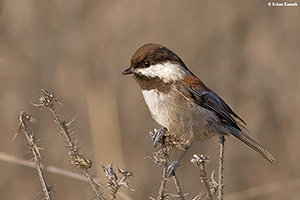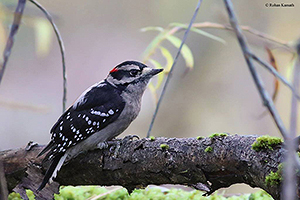Mixed-Species Flocking |
|
|---|---|


 photographs of a Chestnut-backed Chickadee (top) and Downy Woodpecker (bottom) by
Rohan Kamath and an Oak Titmouse by Terry Miller
photographs of a Chestnut-backed Chickadee (top) and Downy Woodpecker (bottom) by
Rohan Kamath and an Oak Titmouse by Terry Miller |
It
is not uncommon to find birds of several species flocking
together. One reason may be that such flocking increases the
number of eyes and ears available to detect predators and
may confuse them as many individuals flee at once. Also a
mixture of species can take advantage of different
abilities. Just as nearsighted zebras with keen hearing
associate on African plains with species such as wildebeest
and giraffes with keen eyesight, so nearsighted gleaning
birds such as Red-eyed Vireos move in groups (on their
tropical wintering grounds) with farsighted salliers like
Yellow-margined Flycatchers. The former lose some prey to
the latter, but apparently are more than compensated by the
latter's early detection of approaching danger. Similarly,
it has been shown experimentally that chickadees and titmice
are used as sentinels by Downy Woodpeckers foraging in
mixed-species flocks. Next to predator defense, however, the most popular hypothesis to explain the formation of mixed-species flocks is an increase in feeding efficiency. Flocks may function to overwhelm territorial defenses, because moving groups are able to feed in areas from which single individuals would be ejected by the "owner" of the territory. Having more individuals searching for food also increases the likelihood that a rich feeding patch will be located. By moving together in a mixed-species flock, birds with the same sorts of diets can avoid areas that have already been searched for food. Individuals in mixed flocks can also learn about new food sources from other species; tits have been observed to visit the site where a woodpecker was pecking at bark and to begin pecking in the same place. Finally, by associating with birds of different species that have somewhat different food preferences and foraging techniques, each individual faces less competition than it would in a similar flock of conspecifics. If the feeding efficiency hypothesis is correct, then the amount of flocking should be related to the availability of food; when food is superabundant, little can be gained by flocking. A test of this hypothesis was carried out in two Ohio woodlots. One woodlot was left undisturbed; the other was provisioned in early November with an ample supply of sunflower seed and beef suet. Downy Woodpeckers, Tufted Titmice, Carolina Chickadees, Brown Creepers, and White-breasted Nuthatches all participated much less frequently in mixed-species flocks in the |
| provisioned woodlot than they did in the control
woodlot. This result supports the hypothesis that
increased feeding efficiency is a major cause of
mixed-species flocking. Similarly, flocks may occur because one species, in the course of its feeding, flushes prey that can be caught by the others. Such foraging associations are called commensal feeding. In Australian rain forests, Yellow Robins follow Brush Turkeys, pouncing on insects the turkeys stir up as they scratch through the dead leaves of the forest floor. Cattle Egrets "flock" with cattle and tractors for similar reasons. There are other interesting aspects of mixed-species flocks. For instance some species appear to take the lead in forming the flock -- to serve as "nuclear" or "core" species. Such species often have conspicuous plumage or behavior. Titmice in North America (and tits in Europe and Africa) play this role, as do antbirds (which often "flock" with army ants and snap up insects their raiding columns disturb) in tropical America, babblers in tropical Asia, fairy wrens and thornbills (tit-like birds) in Australia, and Gerygone warblers in New Guinea. Mixed-species flocks in North America are seen primarily in the nonbreeding season. They tend to have a rapid turnover of species when they are just beginning to form in the late summer as migratory species depart or pass through from more northern locations. It is not in the temperate zones, however, that such flocking reaches its highest development. Mixed-species flocks are a dominant feature in tropical moist forests -- so much so that their arrival can quickly transform an almost birdless patch of forest into an area alive with activity and calling. The composition of these tropical flocks and the complex relationships among their members are just beginning to be elucidated. Some of "our" birds join these flocks on the wintering grounds in Central and South America, and provide one reason for everyone interested in birds to make at least one trip to a tropical forest. |
|
| SEE:
Flock Defense;
Bird Guilds;
Commensal Feeding. Copyright ® 1988 by Paul R. Ehrlich, David S. Dobkin, and Darryl Wheye. |
|